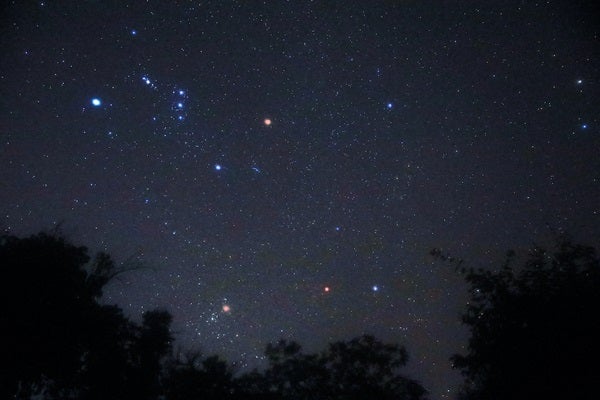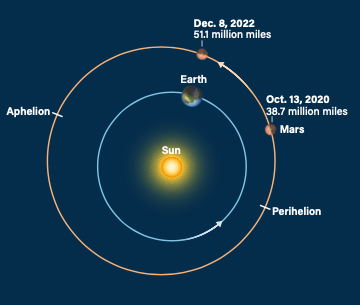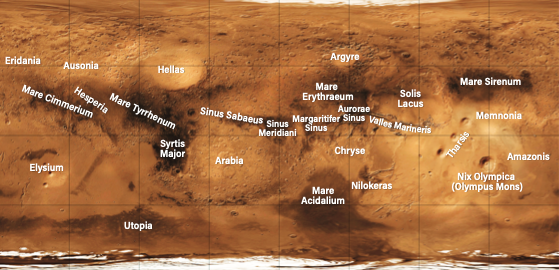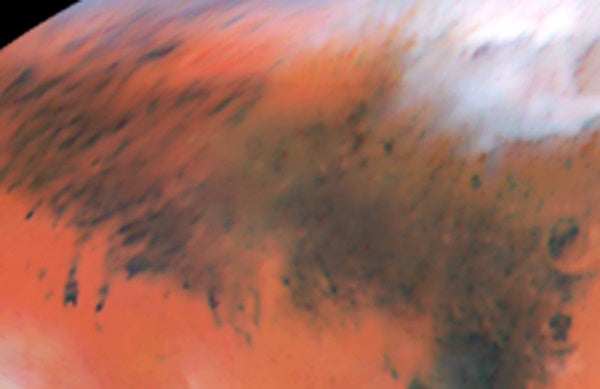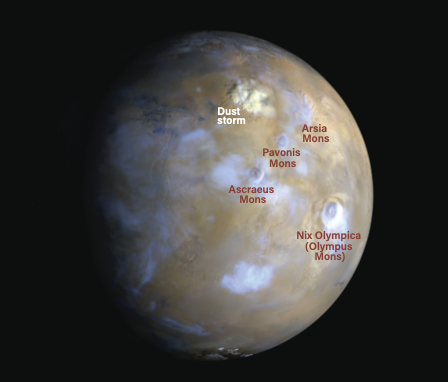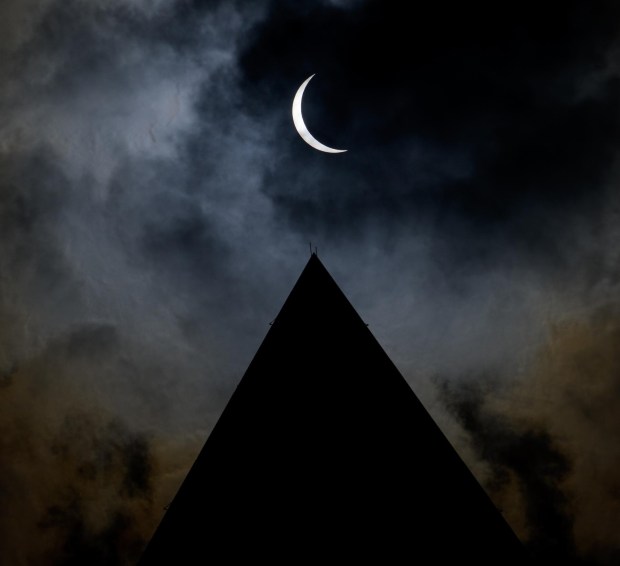This month, Mars observers in the Northern Hemisphere will get a spectacle not seen in over a decade: The Red Planet will be near its highest point in the sky while close to Earth at opposition — the time when Mars is at its brightest and best for the year.
Opposition occurs at 12:36 a.m. EST Dec. 8, just seven days after the Red Planet makes its closest approach to Earth, within 50.6 million miles (81.4 million kilometers) of our planet. Not since January 2007 has the planet been so high in the northern sky while so close to Earth — and it will not happen again until November 2037.
During the weeklong period between close approach and opposition, Mars will appear 17″ in diameter (17.2″ at maximum) and shine at magnitude –1.9 — just 0.6 magnitude dimmer than Jupiter, which will reign overhead with a frosty rose-colored light after sunset.
Naked-eye observers will be able to track the Red Planet as it moves between the horns of Taurus the Bull, becoming the primary beacon in an acute triangle with the reddish stars Betelgeuse and Aldebaran. What’s more, the Full Moon will occult Mars the night of Dec. 7/8, adding another dimension to this unfolding drama. It’s a week of Mars observing not to be missed.
Ready for its close-up
At opposition, Mars will lie directly opposite the Sun, rising in the east as the Sun sets in the west and reaching its highest point in the night sky around midnight. As with the Full Moon (which occurs when the Moon is at opposition), a telescopic view will show a fully illuminated Mars. And while the martian disk will be 5.4″ smaller than during its 2020 opposition, observers at mid-northern latitudes will see the planet some 70° high — 20° higher than in 2020.
If you miss the date of close approach or opposition, that’s OK: The planet will remain 17″ in apparent diameter for a full month, from mid-November to mid-December. Assuming Mars is not covered by a global dust storm, you will have ample time to survey the entire planet at essentially its largest for the year.
What face Mars presents will depend on the time of your observation. Mars completes a full rotation in 24.6 hours, so if you observe the planet at the same time every night, you will see its dark features back up by about 10° every day, creating an illusory retrograde rotation period of around 36 days. On any given night, if you watch Mars for two hours, you will be able to observe an additional 30° of longitude.
The region of Mars facing Earth will be roughly the same at its closest approach (Nov. 30 at 9:11 p.m. EST; longitude 250°) and at opposition (Dec. 8 at 12:35 a.m. EST; 249°). The dark surface features Mare Cimmerium and Mare Tyrrhenum will share the south-central part of the disk. Meanwhile, Syrtis Major will be closer to the limb on the following side (that which has a local time earlier in the day, “following” the preceding side as the planet rotates) of the martian central meridian (the imaginary line that runs from pole to pole and bisects the disk). Note that come opposition, the south polar cap should have greatly receded, with perhaps just a pip of frosty light visible. However, the North Polar Hood — a giant icy cloud that forms over the martian north pole during northern winter — may be prominent.
Three face of Mars
Let’s look now at three faces of Mars and their regions of special interest. To see the most detail, plan to spend at least an hour surveying the planet. Patience is key, as it is during fleeting moments of exceptional seeing that the finest details reveal themselves.
We’ll start with the face visible at the moments of closest approach and opposition, around central meridian longitude 250°.
On this face, Mare Cimmerium and Mare Tyrrhenum split the martian center stage. Both features comprise part of Mars’ heavily cratered southern highlands. Wind whipping different types of sand across the region’s rough and ragged terrain creates a dappled appearance, which the Greek-French Mars observer Eugène Michel Antoniadi (1870–1944) referred to as “leopard skin.” The largest patches can be spied through a 3-inch refractor only under excellent seeing, though CCD imagers capture these features regularly.
Hesperia, a slightly brighter corridor of terrain, separates Mare Cimmerium from Mare Tyrrhenum, while the modestly bright albedo (reflectivity) features Eridania and Ausonia lie immediately to the south of them, respectively. The vast plains of Eridania are of special interest, as NASA’s Mars Reconnaissance Orbiter has identified what appear to be ancient hydrothermal deposits in the region — the likely remains of a vast inland sea that existed 3.7 billion years ago.
Just south of the North Polar Hood is another area of interest, the volcanic complex Elysium. This region frequently harbors clouds, especially in the mid-afternoon on Mars, when warm air containing water vapor rises up the slopes of each volcano and cools at the higher altitude, causing the water vapor to freeze and form a cloud of ice crystals. The high reflectivity of the clouds makes the complex especially apparent, particularly as it nears the preceding (evening) limb.
The celebrated feature Syrtis Major, the darkest on Mars, is a vast elevated plateau covered with basaltic lava that erupted from a low shield volcano. Look for a prominent V-shaped marking. As Syrtis Major nears the meridian, be sure to observe the great Hellas impact basin, which spans 1,400 miles (2,300 km) across. In recent years, its southern portions have at times been bright with fresh windblown dust.
Look Mars in the eye
Mars’ second face is centered on about longitude 100°. It prominently features Solis Lacus, the Eye of Mars, at longitude 85°. Solis Lacus is the most variable large-scale feature on the planet — not surprising, as this vast plain is notorious for producing dust storms that often change its appearance and albedo. At some oppositions, the oculus is dark and conspicuous; at other times, it’s a low-contrast smear. Its appearance this opposition will depend on recent dust storm activity.
Just northeast of Solis Lacus lies the great Valles Marineris — the largest canyon system in the solar system. At 2,500 miles (4,000 km) long, this tectonic crack (with possible ancient water channels) would stretch across the continental U.S. It forms the northern rim of the Eye of Mars and is best seen at magnifications of 250x or greater. Be aware, this feature appears as little more than a dark whisker. On the opposite side of Solis Lacus, to the southwest, look also for the more prominent Mare Sirenum (Sea of Sirens), another section of Mars’ pitted southern highlands. Mare Sirenum follows Solis Lacus and all but points to it.
To the northwest of Solis Lacus lies the Tharsis-Amazonis region. A variety of bright clouds are expected to form on Mars around the time of closest approach and opposition, especially in this region. If you’re fortunate, a W-shaped array of orographic (mountain-hugging) clouds will form over Olympus Mons and the three major Tharsis volcanoes — Arsia Mons, Ascraeus Mons, and Pavonis Mons. Olympus Mons is an enormous shield volcano that measures 370 miles (600 km) across and 16 miles (26 km) high. It is the largest volcano in the solar system.
A touch of flare
The last face is centered on Sinus Meridiani, through which the martian prime meridian passes. It forms the terminus of Sinus Sabaeus, a dark pipestem of material extending toward the junction of Syrtis Major and Hellas. At the western end of Sinus Sabaeus, use high power to look for Dawes’ Forked Bay, though its visibility varies from apparition to apparition.
Nested between Sinus Sabaeus and Sinus Meridiani is the crater Schiaparelli, classically known as Edom Promontorium. This crater has been the site of flares or flashes since 1954. Once mysterious, these flares are now known to be mirrorlike reflections from sunlight glinting off ice crystals in either patches of surface frost or thin clouds in or above the crater, a theory first proposed in 2001 by amateur astronomers Thomas Dobbins and William Sheehan.
This year, during the week between Mars’s closest approach and opposition, five flares are predicted to occur: Dec. 3 at 3:04 a.m. EST, Dec. 4 at 3:40 a.m. EST, Dec. 5 at 4:16 a.m. EST, Dec. 6 at 4:52 a.m. EST, and Dec. 7 at 5:28 a.m. EST. Flares may occur earlier than these times, up to two hours before Edom Promontorium’s central meridian passage.
The dark mass following Sinus Meridiani is composed of two distinct features. One is triangular Margaritifer Sinus, whose chaotic terrain (where flooding occurred on a catastrophic scale, unlike anything seen on Earth) contains Ares Vallis, one of the largest martian outflow channels. The irregular block of Mare Erythraeum, a cratered depression with fluvial, volcanic, and tectonic structures, lies southwest of Margaritifer Sinus. Then, cast your gaze northwest to Aurorae Sinus, whose fingerlike valleys flow northward into the sandy plains of Chryse.
Two more features of note lie at the high latitudes of this face of Mars. South of Mare Erythraeum lies the circular feature Argyre. This 1,000-mile-wide (1,600 km) ringed basin is one of the largest impact features on Mars and was formed nearly 4 billion years ago. Now jump to the planet’s northern hemisphere for the sparsely cratered, eroded volcanic plains of Mare Acidalium (about a quarter of the size of the U.S.) and its southern projection, Nilokeras.
A grand finale
With opposition comes another rare event: the Full Moon will occult a full Mars along a path covering parts of North America, Europe, and Northern Africa. (Areas where the occultation will not be visible include most of Alaska and the southeastern U.S.) The conjunction starts off the U.S. West Coast Dec. 7 at 9:17 p.m. EST and ends over Eastern Europe and Northern Africa at 1:10 a.m. EST Dec. 8. It will take the Moon nearly 40 seconds to consume Mars. Although the exact time of disappearance and reappearance will depend on your location, if Mars passes behind the center of the Moon, the occultation can last almost an hour.
This apparition of Mars will slowly wind down after opposition, but the planet will remain an attractive target into next year. For instance, by the end of December, the planet’s North Polar Hood should start to break up during the martian equinox, exposing the planet’s North Polar Cap — an event that may last well into January. Usually, observations for those using small telescopes end once the planet shrinks to 6″, which occurs in early-April. Skilled observers and CCD imagers will no doubt extend the season until the planet becomes lost in the glare of the Sun in October 2023, leaving us memories of a remarkable time spent with Mars.

